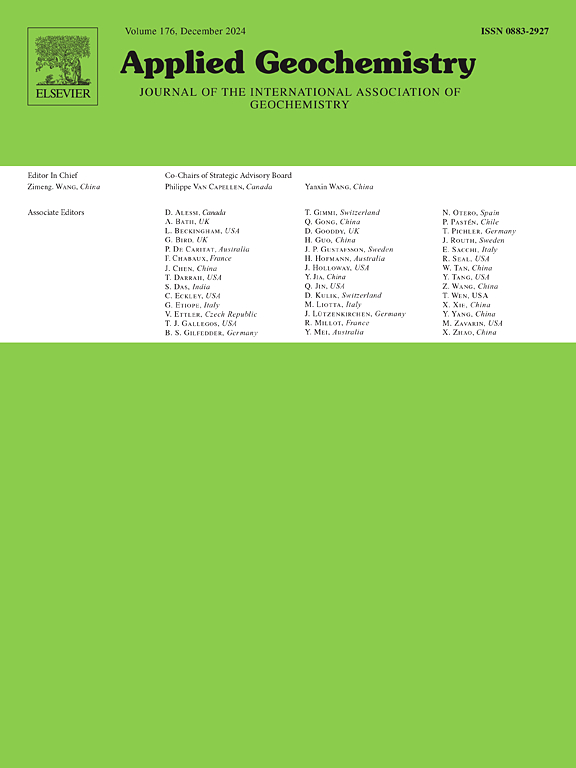利用锂同位素比较开放与封闭系统的风化实验
IF 3.4
3区 地球科学
Q1 GEOCHEMISTRY & GEOPHYSICS
引用次数: 0
摘要
硅酸盐岩石的化学风化作用是碳循环的重要组成部分,也是人工减少大气二氧化碳的潜在方法(“增强风化作用”)。然而,风化作用,特别是由此产生的次生矿物(尤其是粘土)已被证明是难以测量和量化的。在这里,我们使用锂同位素来检查和比较两种不同类型的实验室风化实验,使用相同的初始水和岩石,以确定它们的异同。具体来说,我们比较了“开放系统”实验和“封闭系统”实验,在“开放系统”实验中,反应水滴过岩石粉末,而在“封闭系统”实验中,反应水和岩石在一个封闭的烧杯中接触。结果(元素比、迁移率计算、饱和度指数)表明,封闭实验的水岩相互作用时间越长,次生矿物形成越多。它们较高的“平衡”溶液δ7Li值(δ7Li分别为35.7‰和29.5‰)证实了这一发现。通过测定它们的分馏因子(开放实验和封闭实验分别为α = 0.983±0.004和0.977±0.003)和水与次生矿物之间的分配系数,得出了一个测试案例,以确定风化过程中形成的粘土的数量是否可以单独由Li同位素比值计算,其值与玄武岩的溶解量相似。根据钾的浓度(钾是最易移动的元素),岩石溶解了1.9-3.2克。根据Li同位素,在长达一个月的实验中,沉淀了1.6-2.0 g粘土。这一结果与同位素系统的其他估计一致,这些估计表明粘土的形成是快速的,这反过来又对风化过程产生影响,特别是对增强风化的效率产生影响。本文章由计算机程序翻译,如有差异,请以英文原文为准。
Comparing open versus closed system weathering experiments using lithium isotopes
Chemical weathering of silicate rocks represents a critical part of the carbon cycle, and also a potential method for the artificial drawdown of atmospheric CO2 (“enhanced weathering”). However, weathering and particularly the resulting secondary minerals (especially clays) have proven hard to measure and quantify. Here we use lithium isotopes to examine and compare two different types of laboratory weathering experiments, using the same initial water and rock, in order to determine their similarities and differences. Specifically, we compare “open system” experiments, where the reacting water drips through the rock powder, with “closed system” experiments, where the reacting water and rock are in contact in a closed beaker. The results (elemental ratios, mobility calculations, saturation indices) suggest that closed experiments, with their longer water-rock interactions times, exhibit more secondary minerals formation. This finding is confirmed by their higher “equilibrium” solution δ7Li values (δ7Li = 35.7 versus 29.5 ‰, respectively). The determination of their observed fractionation factors (α = 0.983 ± 0.004 and 0.977 ± 0.003 for the open and closed experiments, respectively) and partition coefficients between water and secondary minerals yields a test case, to determine whether the amount of clays that form during weathering can be calculated solely from Li isotope ratios, giving values similar to the amount of basalt dissolved. Based on potassium concentration (here the most mobile element), 1.9–3.2 g of rock was dissolved. Based on the Li isotopes, 1.6–2.0 g of clay was precipitated during the month-long experiment. This result agrees with other estimates from isotope systems, which suggest that clay formation is rapid, which in turn has consequences for weathering processes, and especially for the efficiency of enhanced weathering.
求助全文
通过发布文献求助,成功后即可免费获取论文全文。
去求助
来源期刊

Applied Geochemistry
地学-地球化学与地球物理
CiteScore
6.10
自引率
8.80%
发文量
272
审稿时长
65 days
期刊介绍:
Applied Geochemistry is an international journal devoted to publication of original research papers, rapid research communications and selected review papers in geochemistry and urban geochemistry which have some practical application to an aspect of human endeavour, such as the preservation of the environment, health, waste disposal and the search for resources. Papers on applications of inorganic, organic and isotope geochemistry and geochemical processes are therefore welcome provided they meet the main criterion. Spatial and temporal monitoring case studies are only of interest to our international readership if they present new ideas of broad application.
Topics covered include: (1) Environmental geochemistry (including natural and anthropogenic aspects, and protection and remediation strategies); (2) Hydrogeochemistry (surface and groundwater); (3) Medical (urban) geochemistry; (4) The search for energy resources (in particular unconventional oil and gas or emerging metal resources); (5) Energy exploitation (in particular geothermal energy and CCS); (6) Upgrading of energy and mineral resources where there is a direct geochemical application; and (7) Waste disposal, including nuclear waste disposal.
 求助内容:
求助内容: 应助结果提醒方式:
应助结果提醒方式:


